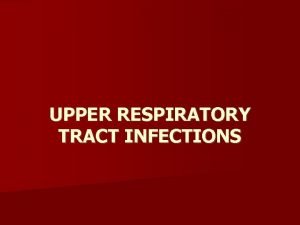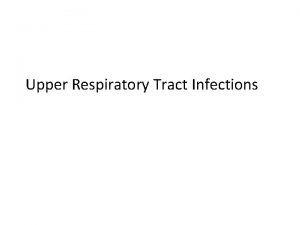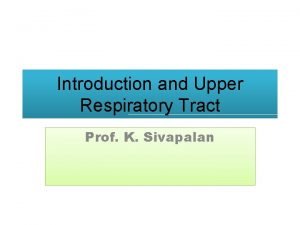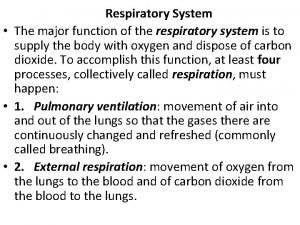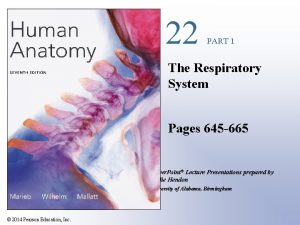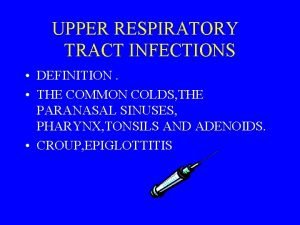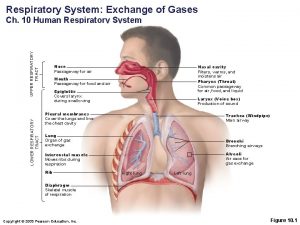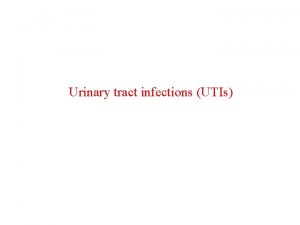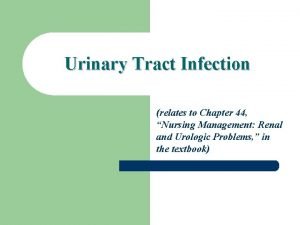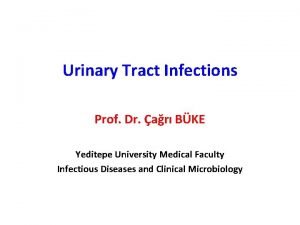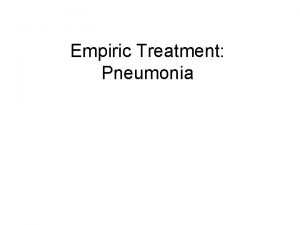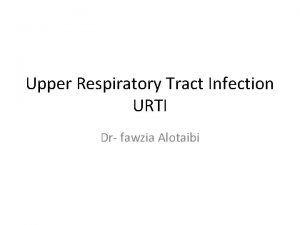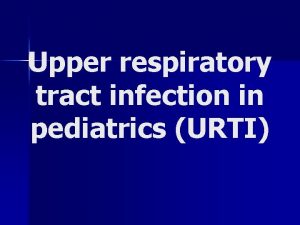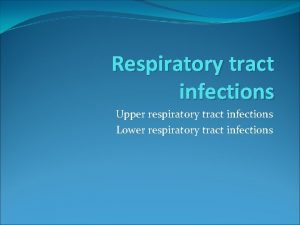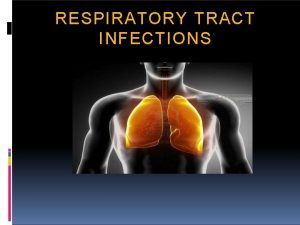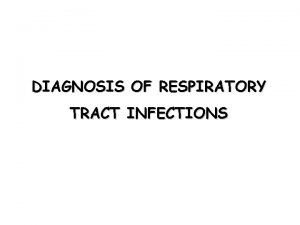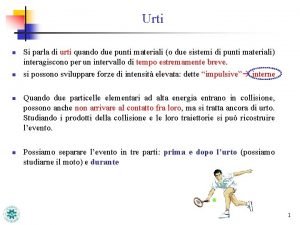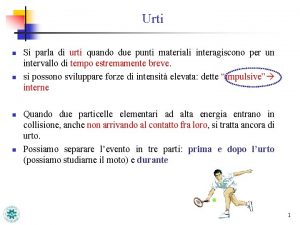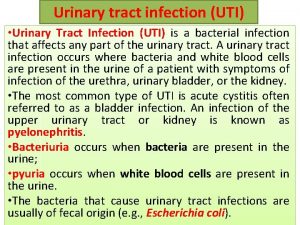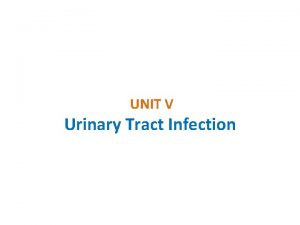Upper Respiratory Tract Infection URTI Dr Ali Somily















- Slides: 15

Upper Respiratory Tract Infection URTI Dr Ali Somily

Objection To learn the epidemiology and various clinical presentation of URT To identify the common etiological agents causing these syndromes To study the laboratory diagnosis of these syndromes To determine the antibiotic of choice for treatment

Definition Pharyngitis Otitis Media Sinusitis Epiglottitis

Pharyngitis Late fall, winter, early spring 5 to 15 years erythema, edema, and/or exudates Tender, enlarged >1 cm lymph nodes Fever 38. 4 to 39. 4º C No signs and symptoms of viral infections

Pharyngitis Etiology Viral is the most common i. e Enterovirus, HSV, EBV, HIV, Respiratory viruses Bacterial Group A streptococcus Neisseria gonorrhoeae Anaerobic bacteria i. e Lemierre's syndrome Corynebacterium diphtheriae

Corynebacterium diphtheriae One of the most common causes of death in unvaccinated children 1 -5 yrs. Toxin mediated disease Rapid progression tightly adhering gray membrane in the throat Tinsdale media ELIK’s Test for confimation Penicillin or erythromycin

Epiglottitis Usually young unimmunized children presented with dysphasia, drooling, and distress H. influenzae Type b S. pneumonae S. aureus or Beta hemolytic streptoccus Viral or candida Ceftriaxone

Pertussis (whooping cough) Bordetella pertussis (GNB) Pertussis toxin (PT )* Filamentous hemagglutinin (FHA Pertactin (PRN) Incubation period 1 to 3 wks Catarrhal Stage 1 -2 weeks Paroxysmal Stage 1 -6 weeks Convalescent Stage 3 -6 weeks Leukocytosis with lymphocyte predominance Nasopharyngeal (NP) swabs Charcoal-horse blood T media Regan-Lowe, Bordet-Gengou Treatment erthromycin and prevention vaccination

Acute otitis media S. pneumoniae H. influenzae GAS S. aureus Moraxella catarrhalis Viral and fungal Tympanocentesis Complication mastoiditis chr o m , meningitis Amoxicillin or AMC Mastoiditis treat for 2 wks

Bacterial sinusitis Acute sinusitis Children Mainly clinical diagnosis Aspiration in case Immunocompramized , treatment failure Diagnosis X-rays CT/MRI Periorbital cellulitis R/O sinusitis by CT/MRI Post-septal involvement treat as meningitis Chronic sinusitis Less local symptoms Mimic allergic rhinitis Dx Image less useful than acute (changes persist after TTT) and to R/O tumor Obtain odontogenic X-rays if maxillary sinus

Bacterial sinusitis Acute sinusitis S. pneumoniae H. infuenza M. catarrhalis Treatment Quinolones or Ceftriaxone For 1 -2 weeks Chronic sinusitis S. pneumoniae H. infuenza M. catarrhalis Oral anaerobes Treatment Same as acute sinusitis Duration For 2 -4 weeks

Clinical Presentations of Sinusitis

Deep neck space infections Lateral pharyngeal, retropharyngeal or prevertebral space Patients are toxic with unilateral posterior pharyngeal soft tissue mass on oral exam Neck stiffness with retropharyngeal space infection/abscess Retropharyngeal ( danger space) infection may extend to mediastinum and present as mediastinitis Prognosis is poor without surgical drainage

Deep neck space infections treatment Usual pathogens Oral streptococci and anaerobes TTT Merpenem or Pipracillin Clindamycin Duration 2 weeks

Other Infections Lemierre’s syndrome As a complication peritonsillar abscess or post-dental infection Patient present with sore throat, fever and shock due IJV thrombophlebitis which leads to multiple septic emboli in the lung Fusobacterium necrophorum Medical TTT same as deep neck space infection Venotomy if not respond to medical treatment
 Classification of upper respiratory tract infection
Classification of upper respiratory tract infection Conclusion of respiratory tract infection
Conclusion of respiratory tract infection Acute upper respiratory infection unspecified คือ
Acute upper respiratory infection unspecified คือ Upper respiratory tract
Upper respiratory tract Anatomy of the upper respiratory tract
Anatomy of the upper respiratory tract Structure of the upper respiratory system
Structure of the upper respiratory system Ethmoditis
Ethmoditis Upper respiratory tract
Upper respiratory tract Upper rti
Upper rti Upper and lower respiratory system
Upper and lower respiratory system Urinary tract infection in pregnancy ppt
Urinary tract infection in pregnancy ppt Urised otc
Urised otc ç
ç Sexually transmitted diseases
Sexually transmitted diseases Transitional epithelium ureter
Transitional epithelium ureter Complicated urinary tract infection
Complicated urinary tract infection
